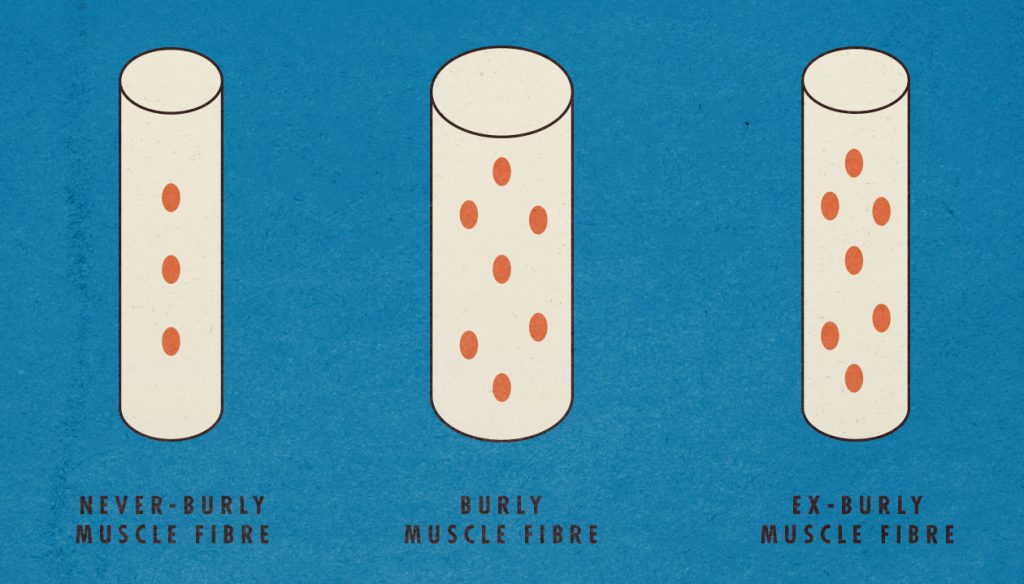
Bulking Set Point and “Muscle Memory”
You could think of your body as having a built-in bodyweight thermostat. You might have your weight set at, say, 130 pounds. If you go above 135, your appetite automatically turns off until you get back to 130 pounds. If you go below 125 pounds, your appetite automatically turns on until you get back up to 130 pounds. There’s more at play here than just your appetite, but you get the idea: your body is automatically regulating your weight around a given “set point.”
When you’re bulking up, you’re fighting that set point. It’s trying to regulate your body weight back down. It’s trying to eliminate all the progress you’ve made.
So how do we get your set point to 150, 180 or even 200 pounds? Is that even possible? That’s what this article is about.
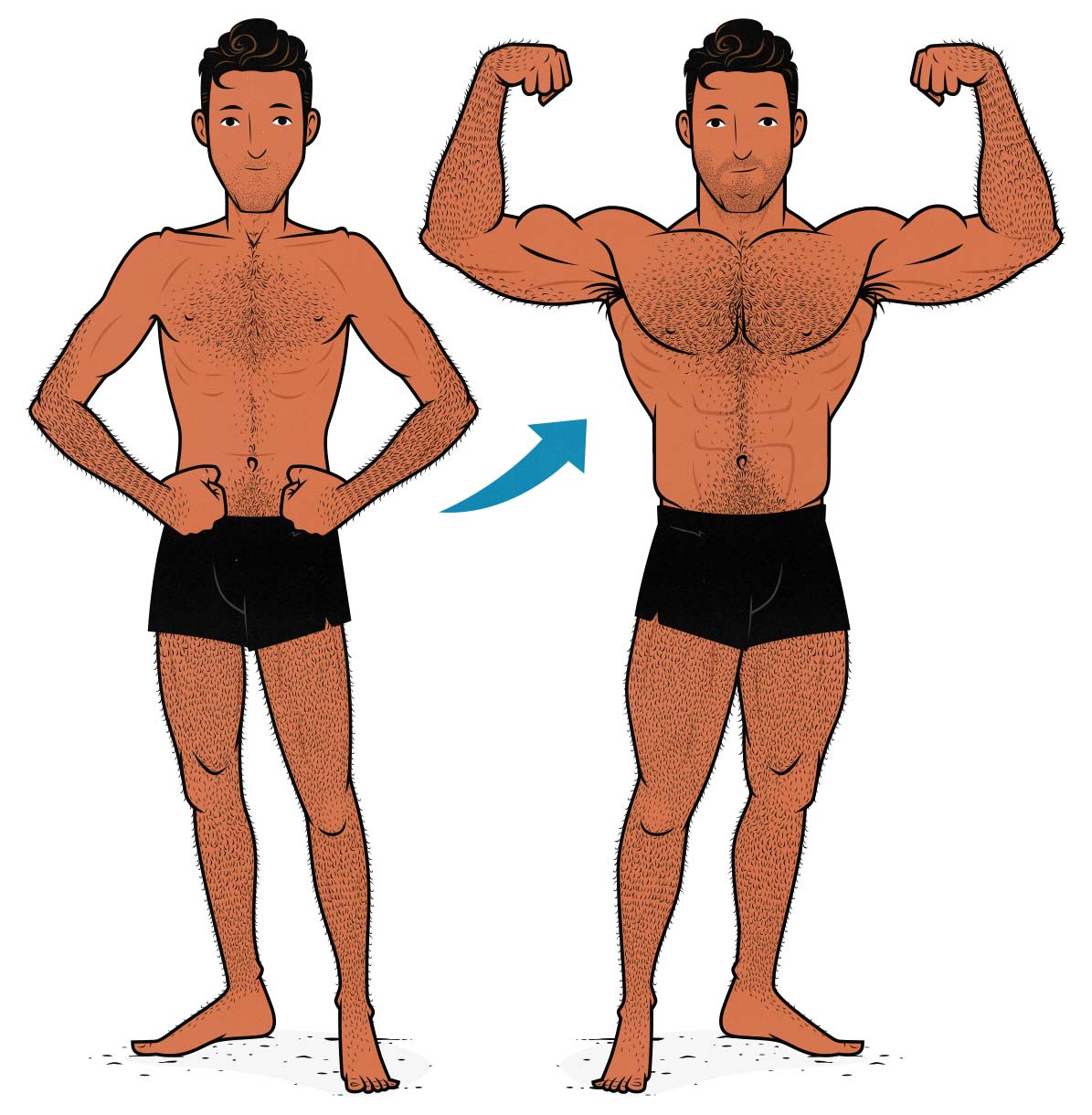
Introduction
When I first started building muscle, I was desperate for it. I was willing to make it a huge priority in my life, and while the idea of having to go to the gym and eat a bulking diet was daunting, I was willing to do whatever it took. I was even willing to take creatine (which seemed like steroids to me at the time).
Fast forward a few months and I’m realizing, okay, I can do this, but damn, is this my life forever? Am I going to be full every moment of my entire life? Am I always going to have this crippling muscle soreness and inflammation?
I gained twenty pounds that summer, bringing me from 130 pounds up to 150 pounds. It wasn’t a lifestyle change, though, it was just this crazy summer bulking challenge. When my semester at university started back up, I completely forgot about bulking. I went back to the same sedentary lifestyle as a deskbound design student.
Around a year later, I realized that I was starting to look out of shape again, so I got back into bulking. That second time around, I went from 150 up to 170 pounds. I’d added another twenty pounds, making me forty pounds heavier than when I started.
That time, some of the muscle-building habits stuck. I started living a healthier lifestyle. I was eating more vegetables and protein, and I was exercising 2–3 times per week.
I felt better, I looked better, and I had developed a hobby of helping skinny guys bulk up online. A year later, Bony to Beastly was starting to take shape, and I wanted to test the program. That brought me from 170 up to 185 pounds:
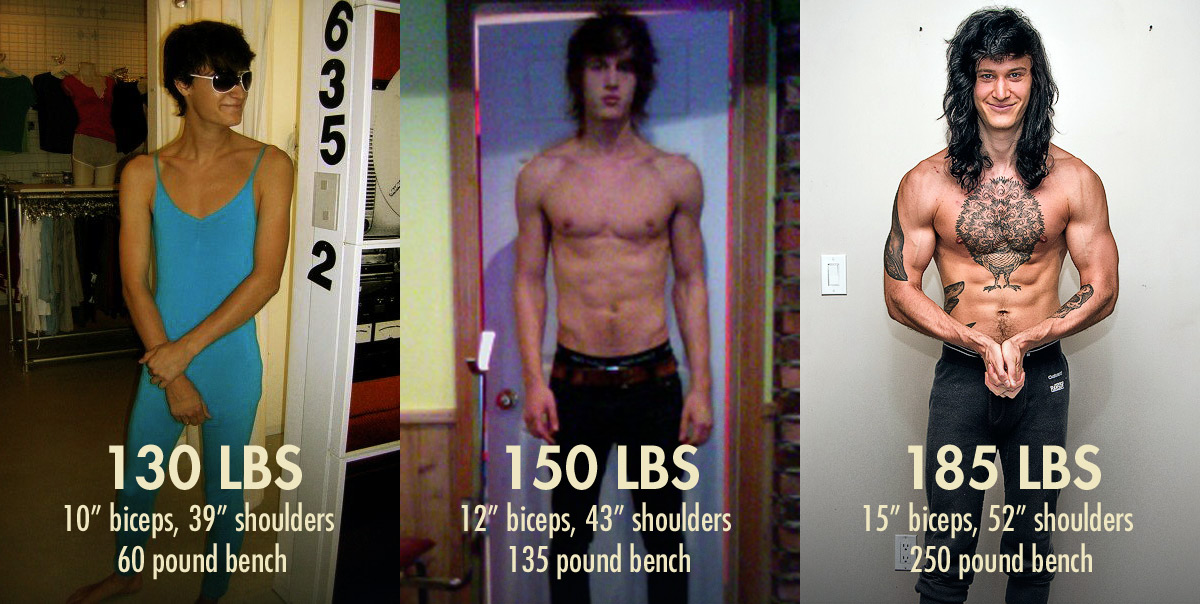
This time, every habit stuck. My diet was made up of at least 80% whole foods, I naturally ate enough protein, my appetite helped me maintain that higher body weight, and I was absolutely locked into my routine of lifting weights 2–3 times per week.
I also enjoyed it.
Best of all, I didn’t need to worry about having to bulk up ever again. My set point now seems to be at around 185 pounds. It will drift up five pounds when life is easy, but no higher. And it will drop down five pounds if I get sick or go travelling, but no lower.
Just like I would never fall to less than 125 pounds when I was hovering around 130 pounds, now I’ll never fall under 180 pounds.
I wouldn’t have expected that. I didn’t know my thermostat could be adjusted. In fact, up until that point, I had been worried that it wasn’t adjusting.
I wish there had been an article like this one. An article that I could have read at all these different points so that I could have avoided the doubt and confusion. Most of all, I wish this article had existed back when I was 130 pounds—back when I was worried that bulking up meant eating a bulking diet forever.
Wherever you are on your journey, this article should help. I can also answer any questions you have about your specific situation in the comments.
First, though, we have to understand the muscle-building process a little better. Some adaptations are transient, some are durable, and some are totally permanent. Once you understand these differences, we’ll be able to cover the how-to.
Some Muscle Gains Are Permanent
Your muscles will adapt in a few ways. Some adaptations are permanent, some remain changeable, and some are fleeting. If you get hung up on the fleeting adaptations, you’re going to find yourself very confused. On the other hand, if you rely only on the permanent adaptations, it’s going to be hard for you to look your best on a day-to-day basis.
First, let’s look at how your muscles will grow over time.
The Newbie-Gains Stage
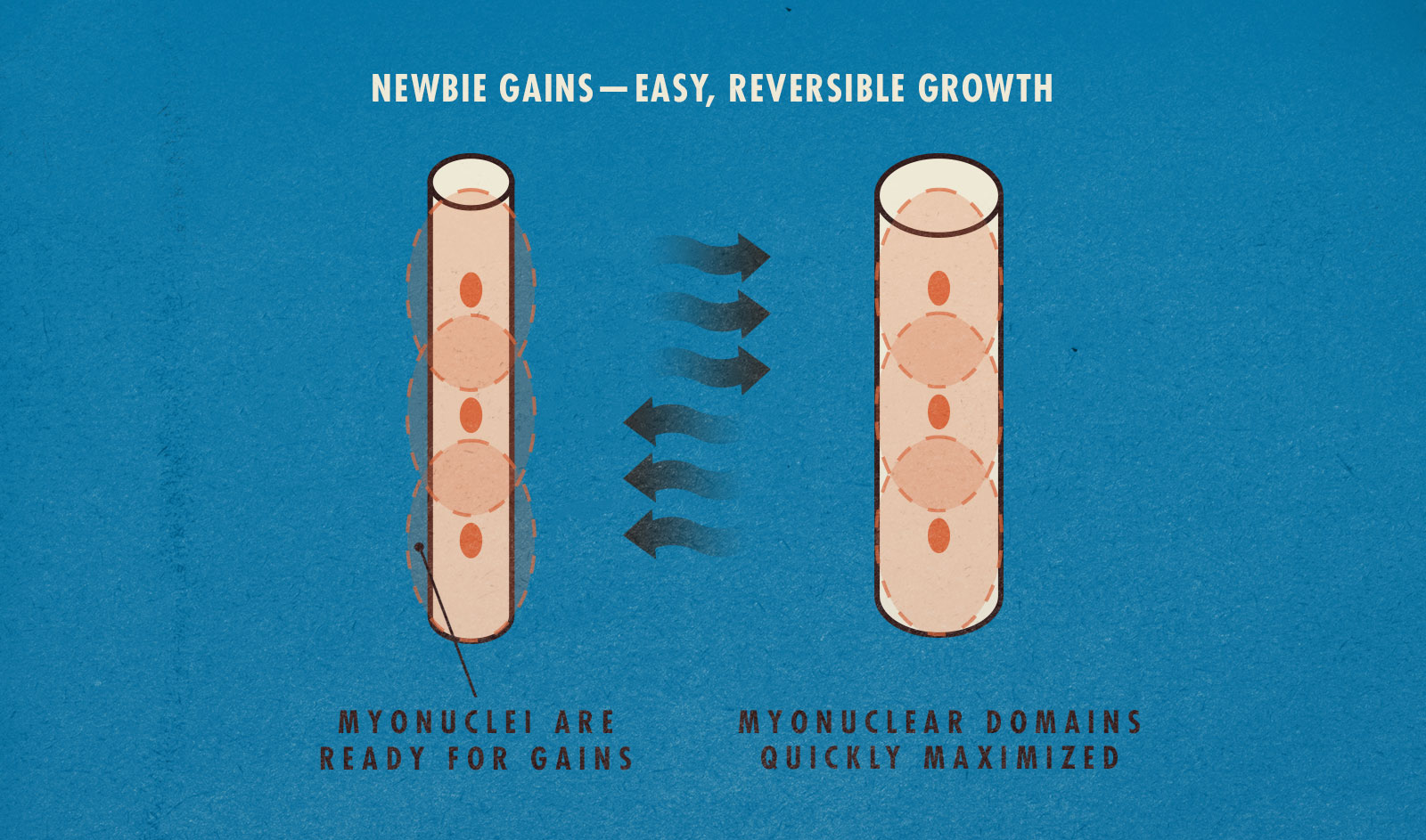
First, newbie gains. We have an entire article on newbie gains where we go over this science in even more detail, but long story short: when you first start lifting weights, your muscles will explode with rapid growth. It’s quick, it’s fairly easy, and you’ll grow as fast as you can shovel food into your mouth. (Mind you, eating that much food is hard, so it pays to learn how to eat more calories.)
Newbie gains are exciting, but they can also be frustrating. Your muscles can seem fragile. They won’t have a permanent feel to them yet. They can disappear just as fast as they show up.
This muscle is easy to gain, easy to maintain, but it isn’t permanent. It doesn’t seem like it does much to adjust your set point, as you can still move freely between the two states, letting your muscle fibres swell up to their maximum nuclear domains and then shrink back down. You’ll get better at this process, so it will be easier to regain the muscle than it first was, but your body hasn’t changed on a deep level yet.
The confusing thing about newbie gains is that if you don’t transition into making intermediate gains, your new muscle mass can feel pretty temporary. You’ll look a lot better, and it won’t be hard to maintain your gains, but if you travel or get sick for an extended period of time, you might shrink back down to where you were before.
If you never progress beyond this point, you may never realize that muscle gains can be a lot sturdier than this.
Intermediate Muscle Gains
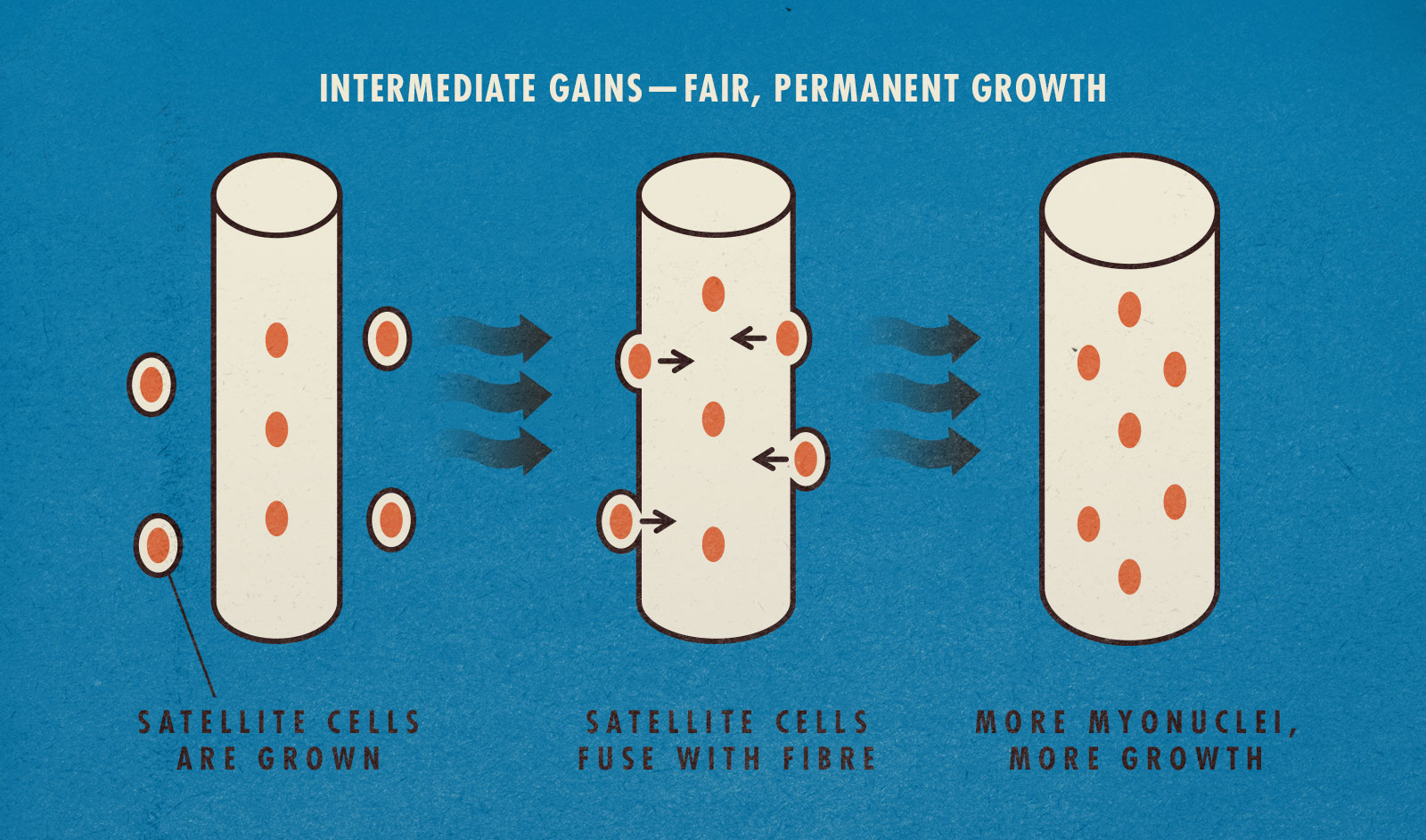
Intermediate gains will unlock your next stage of muscle growth, and you can keep progressing here for a good few years. This is where the vast majority of your gains will be made.
Now, to be clear, there are a lot of ways to sort lifters into beginner, intermediate, and advanced stages. We aren’t talking about lifting skill or even strength, we’re just talking about how close to your genetic muscle-building potential you are.
We define intermediate gains as the stage when you can slowly add more nuclei to your muscle fibres. Your newbie gains are your first six months or so, at which point you start transitioning to your intermediate gains, which can last for several more years.
Now, it’s worth pointing out that there’s a certain amount of overlap between these stages. You’ll start getting these adaptations before you finish getting your newbie gains.
The point is, though, that newbie gains will take you from being skinny to being fit. And then this intermediate period is where you’ll go from being fit-but-thin to being truly strong and muscular.
However, the intermediate stage is also where you risk running into plateaus. You’ll run into strength plateaus if your hypertrophy routine isn’t good enough, and you’ll run into body-weight plateaus if you aren’t able to eat enough calories. Once you move beyond the beginner stage, you need to move beyond beginner programs.
Most of these intermediate adaptations are really good, though. You’ll gain a lot of muscle, your lifting coordination will get better, your stomach will grow physically bigger, your digestive system will grow stronger, your bones will grow denser, and you’ll become more experienced with lifting and nutrition. These changes are harder to come by, but they’re incredibly good for you, and many of them are also permanent.
See, the process of adding satellite cells to your muscle fibres can be challenging, but it’s also totally permanent. You are forever changing your genetics with every step of progress you make. This makes it way easier to be lean and muscular for the rest of your life.
Even if you stop lifting weights or eating a bulking diet, your muscles won’t go back to how they were before, they’ll just temporarily deflate a little bit, like so:
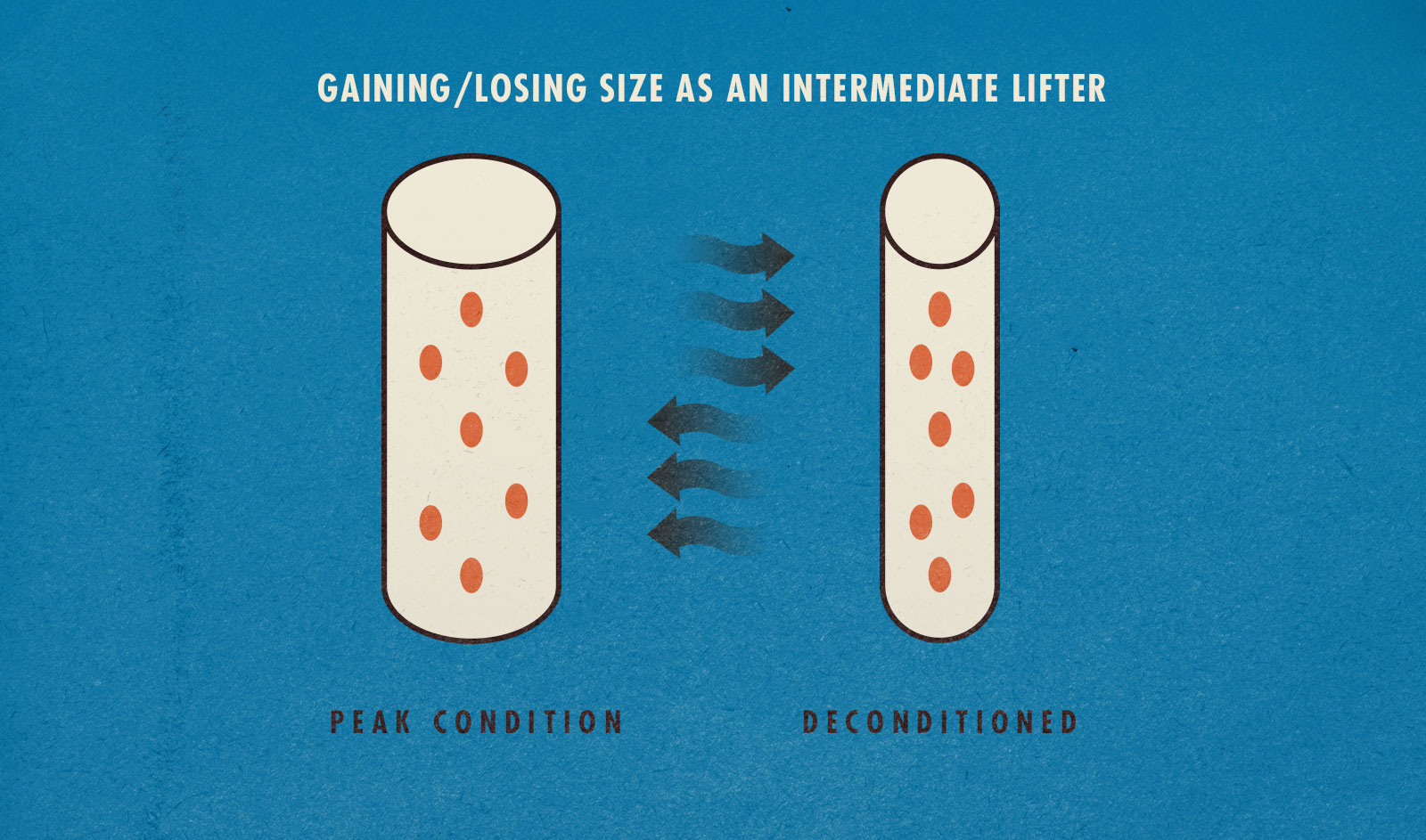
The red dots, which represent the nuclei, stay in your muscle fibres. That allows your muscle fibres to pop back up to full size as soon as you start lifting enough and eating enough again. Moreover, your muscles will naturally hover around a bigger set point. Even when you lose weight, you’ll still have better muscle definition and strength.
You can take this fairly far, improving yourself in a permanent way with every bit of progress. If you add even more nuclei to your fibres, the effect will be even more dramatic, like so:
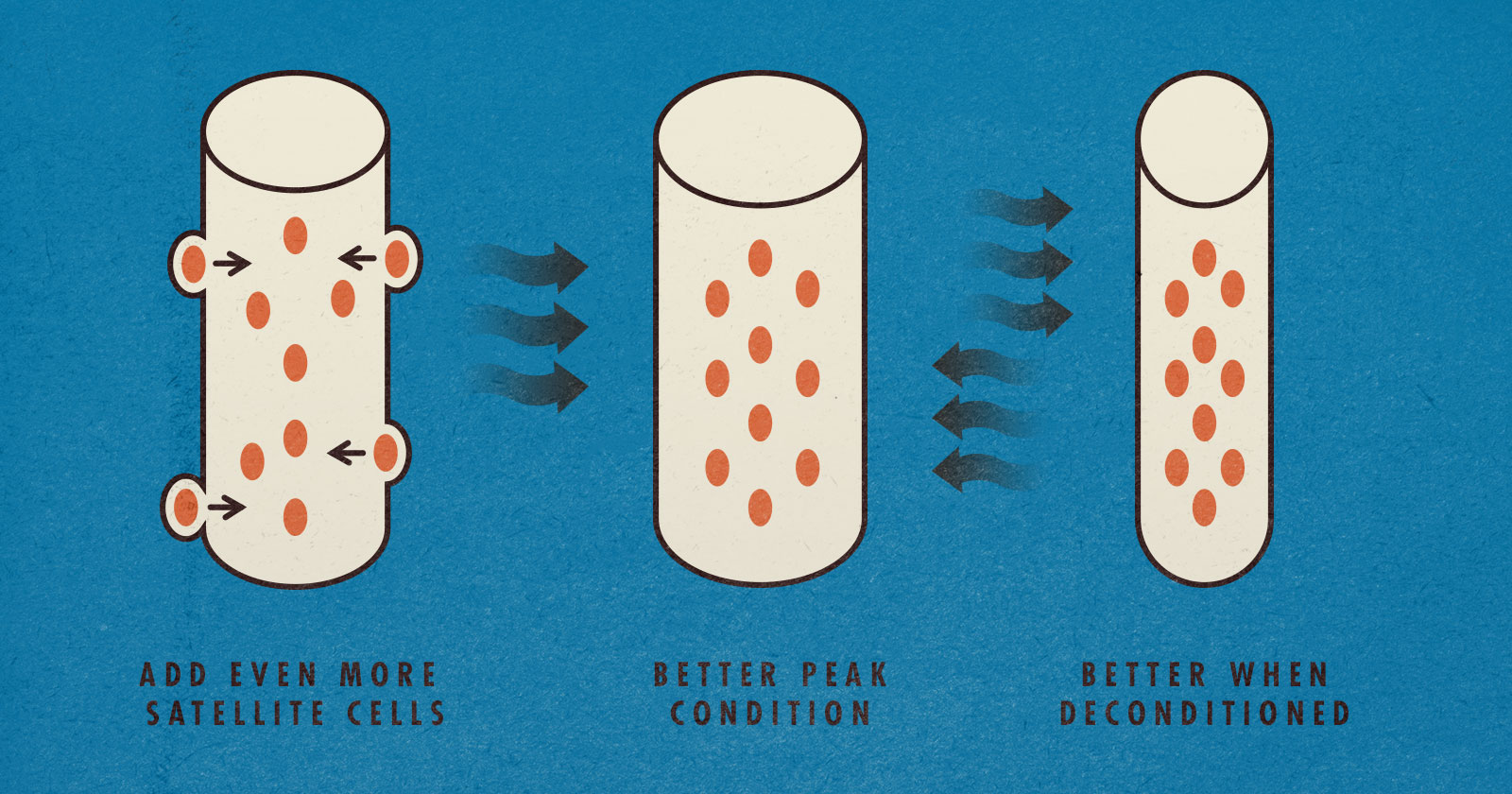
Your muscularity will still fluctuate during good and bad times, but you’re going to look far better even when you’re deconditioned, and it’s going to be fairly quick and straightforward to get back into peak condition.
For a well-documented example of this, check out Tim Ferriss regaining 30 pounds of muscle in a month with just a couple minimalist workouts per week:
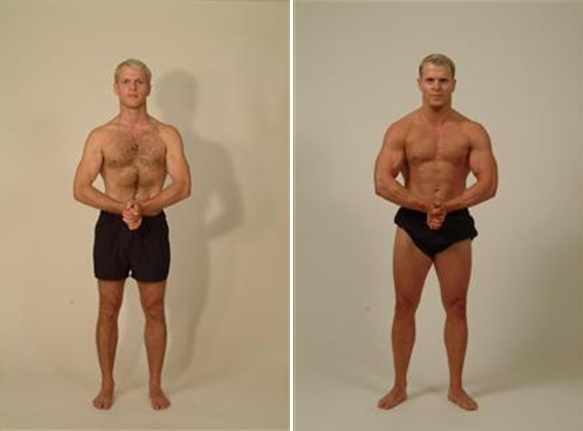
Also notice that after a couple of years away from lifting (left), he still looks like a fit and strong guy. If I recall the story correctly, he was travelling around learning how to dance, and his dance partners would comment on how muscular he was. Not a bad deconditioned state!
You’ve probably noticed actors transforming themselves like this, gaining or losing thirty, forty, or even sixty pounds of muscle on a whim depending on the role they’re playing.
For example, this muscle memory phenomenon is how Christian Bale could intentionally lose sixty pounds between Reign of Fire and the Machinist, then spend just a few months getting back in shape for Batman:
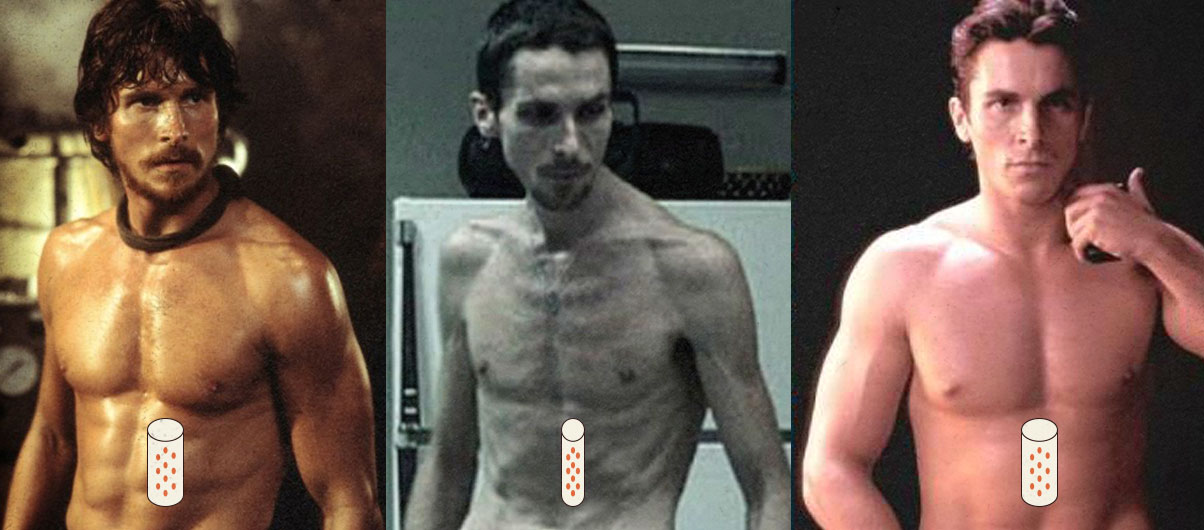
Advanced Muscle Gains
If you get even closer to your muscle-building potential, you can start making another type of adaptation. The science isn’t very well developed here, and I won’t go too far into it, but a dominant hypothesis is that your muscle fibres start splitting into two. If this takes place, your muscle fibres not only become better, but you also develop more of them!

When you get to these very advanced levels you can rebuild incredible amounts of muscle in very short periods of time. A famous example is Casey Viator regaining 63 pounds of muscle in 28 days. (Also of note here is how jacked Casey Viator is in his deconditioned state!)
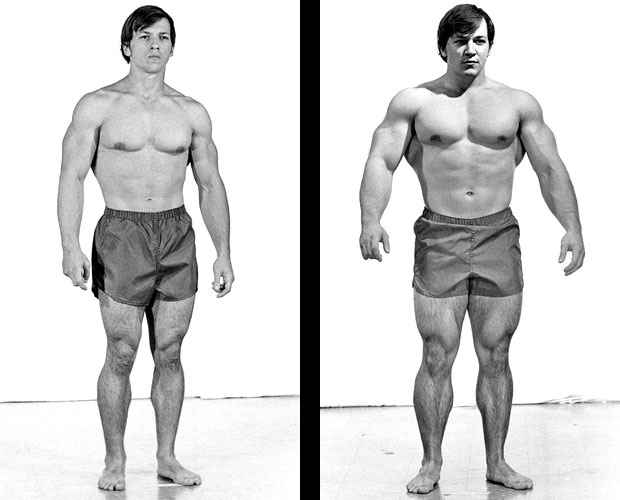
You can read more about Casey Viator’s transformation in our in-depth article on hypertrophy training.
As you can guess, there’s more to this story than just lifting and eating big. He was a professional bodybuilder who took steroids, which can certainly have an impact on how this stuff works.
Some Muscle Gains are Transient
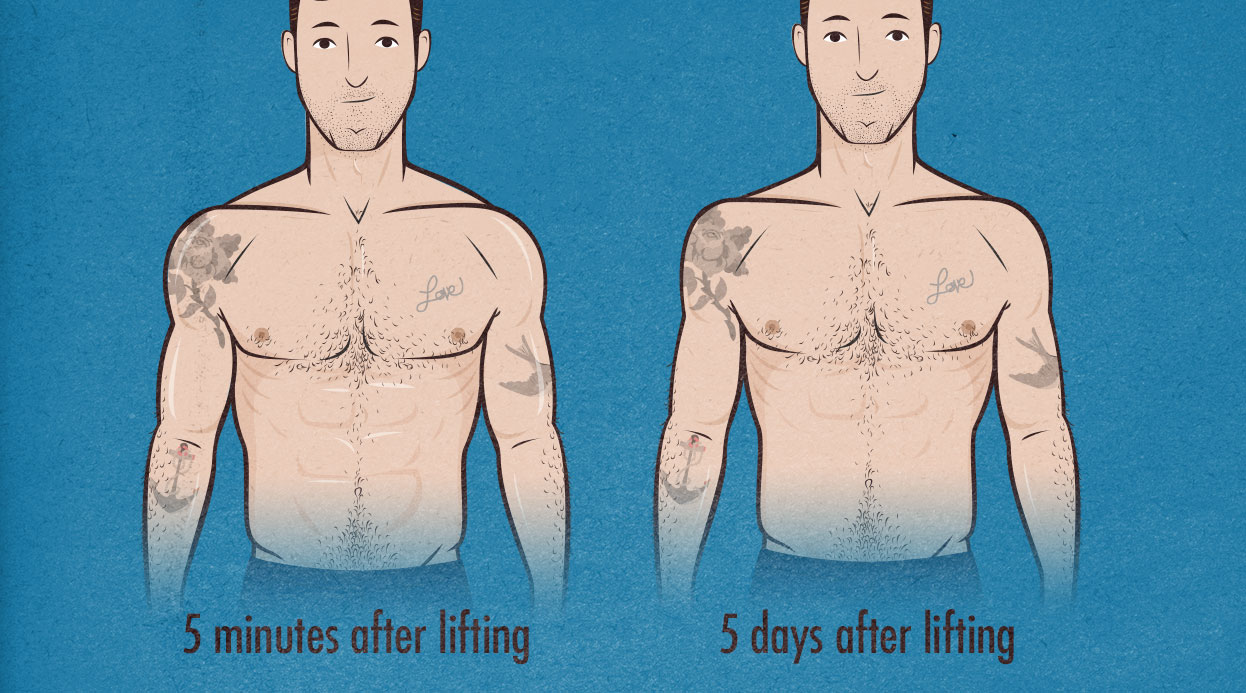
The best example of this is the pump. You can go to the gym, do a full-body workout, inflate up to an awesome size, and then deflate back down on your way back home.
If you met Hugh Jackman an hour after he pumped up for his shirtless Wolverine scene, he’d already be looking more like a normal person again.
There are other lesser-known changes that are transient, though. Let’s talk about a few different things that influence how strong you look:
- The pump. Getting a good pump can temporarily add a good inch to your bicep size. It can also make you look far more lean and vascular, especially if you’re under 15% body fat. But it’s so short-lived that it often won’t survive the trip home from the gym.
- Inflammation. If you go to the gym and stress your muscles, they’ll get a little inflamed over the next couple days. You might feel some muscle soreness (DOMS) during this time. You’re also going to look pretty good! That inflammation is only in your muscles, so it’s only your muscles that appear to be a little larger. If you get into the routine of doing full-body workouts a few times per week, your entire body will always look like this. Then when you go on vacation, you’ll go back to having fully recovered muscles, and you’ll start worrying that you’re already losing muscle mass. You aren’t. Your muscles are actually in better shape than they were yesterday. They’re now fully recovered.
- Fullness. If you eat a bunch of food, you’ll have more food moving through your digestive system. This will make you weigh more on the scale, it will make you look bigger… and it will make you look fatter. This might make you worried on two levels. First, you may worry that you’re getting fat because you’re looking a little pregnant. Second, as soon as you stop eating quite so much food, you’ll lose a couple pounds within a day or so. At that point, you might worry that you’re losing muscle mass with just a day of eating a regular amount of food. You aren’t, there’s just less food travelling through your digestive system. You might retain a little less water as well.
- Dryness. Bodybuilders are known to manipulate their water weight, but fighters take the prize here. Guys in the UFC, for example, are notorious for dropping 20+ pounds of water for their weigh-in, then re-inflating back to full size for their fight the next day. It’s a miserable and somewhat unhealthy process, and you’re unlikely to do it by accident. However, you can also get a lesser version of this if you go out drinking. Alcohol is a diuretic, meaning that it dehydrates you. After a night of drinking, you might wake up the next morning quite a bit lighter. Guys normally don’t mind how they look in this state since it makes them look leaner, but it can freak us skinny guys out because of the weight loss. Fortunately, the alcohol hasn’t destroyed our gains, we just need to rehydrate! Anyway, bodybuilders call this looking “dry.”
- Flatness. If you eat a bunch of carbs, your muscles are going to swell up with glycogen. This is especially true if you’re in the habit of lifting weights, and also if you’re a male. When you get out of the habit of lifting weights or eating a carb-filled diet, your muscles won’t hold onto as much glycogen, and they’ll deflate a little. Bodybuilders call this looking “flat.” (This is also why some people start to look smaller when they start eating a ketogenic diet.)
If you add up all these things, you can see how a guy might be pretty stoked about the gains he’s made, go on vacation, and within a few days be panicking because he doesn’t look like the selfie he took at the gym the other day.
I have a simple solution for this: overshoot your goal physique by 5–10 pounds.
I know that might not be possible yet. In the meantime, just remember that a few of the pounds you see in the mirror after a good lifting session aren’t real yet. A few days later you’ll look like you’ve gained 2% body fat and lost 5 pounds of muscle.
There’s a plus to these transient changes, though, as they’re a good incentive to stay in a good lifting and eating routine. That way you’ll always look your best.
I do want to stress that these changes may seem extreme from your perspective, but most people won’t notice. You don’t need to stress about them, and part of leading a Beastly lifestyle is not being the kind of guy who’s scared to take his shirt off if he’s feeling a little bloated or flat.
You Won’t Need to Eat a Bulking Diet Forever
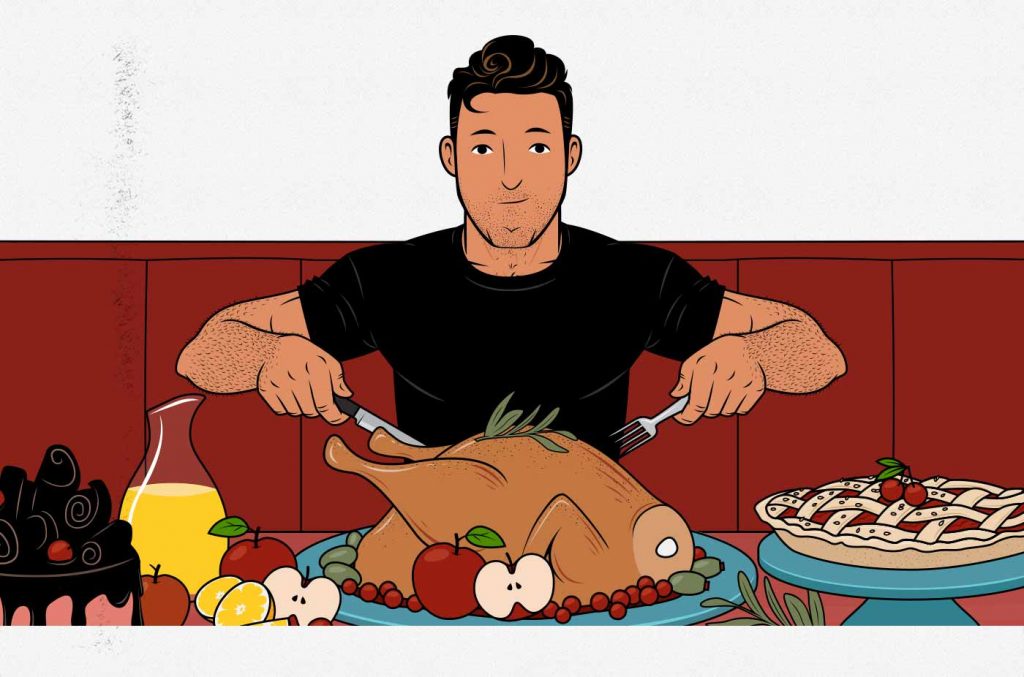
To gain around a pound per week, you need to eat about 500 extra calories every day. As you get further into your bulk, you may find that your metabolism starts chasing you. You keep eating that same 500-calorie surplus, but slowly you start gaining less and less weight. Soon, you aren’t gaining weight anymore. You need to raise your calorie intake even higher. Oh no!
This is fat-people heaven, but we’re not fat people.
At this point, most skinny guys get scared. We fear that the muscle we’ve built is what’s burning all of those extra calories, so as soon as we stop eating those extra calories, we’ll lose all the muscle we worked so hard to build.
Fortunately, that’s not the case. A pound of muscle only burns 6 calories per day. You’d have to build 83 pounds of muscle in order to burn 500 extra calories per day. Your metabolism hasn’t adapted to your new muscle mass, it’s adapted to your overeating.
This doesn’t happen to most people. Not everyone has a highly adaptive metabolism. “Hardgainers” are known for it, though, and most of us naturally skinny dudes are hardgainers. When we eat more calories, we fidget more, we radiate more body heat, and so our metabolisms rise.
The good news is that this metabolism change will only last so long as we’re overeating. You can cut those 500 calories out of your diet and you will not lose any muscle. Worst case, you might look a little flat because you aren’t holding onto quite as much muscle glycogen.
So let’s say you normally eat 2,250 calories. You add in 500 calories and begin your bulk at 2,750 calories. You gain weight, but as you gain weight, your metabolism rises higher, so you’re forced to gradually raise your calorie intake to keep up with your rising metabolism.
After a few months of bulking, let’s say that you’ve gained 27 pounds. A skinny guy’s dream. But you’re also eating a whopping 3,750 calories. 1500 more calories than when you started bulking. A skinny guy’s nightmare.
At this point, most of us are panicking because we think we’ll have to keep eating like this forever, or that we’ll only be able to cut 500 calories off, bringing us to a still-whopping 3,250 calories per day just to maintain our physiques.
Fortunately, our new calorie intake just needs to accommodate the calorie needs of our new muscle mass, and muscle only burns six calories per pound. So our new calorie requirements are more like 2,250 + 162. Not a big difference, and your stomach and digestive system will have adapted to this new intake anyway. You can go back to eating according to your appetite. No problem. This is your new body-weight set point.
(Now, it’s worth noting that carrying around more muscle, and especially lifting heavy weights with that new muscle, will add extra calorie needs into the mix, but not a lot. This is more of a concern for long-distance runners and cyclists, as any extra weight they’re carrying around can add up over long distances. Not an issue for regular guys, even if they have an active job.)
Eating a bulking diet will always be hard, as it’s stressing your system. You’re challenging your natural homeostasis mechanisms.
However, eating a maintenance diet, no matter how much muscle you build, should always feel fairly natural—at least once you get used to it. (Assuming you made your muscle gains naturally, anyway. I’m not sure how steroids would change things.)
After all, as we bulk up, our appetites and digestive systems bulk up as well.
You Can Take Breaks While Bulking
If you’ve successfully finished you’re bulk, or even if you’re partway through bulking and overwhelmed with how high your calorie needs have climbed, you can always bring your calories back to maintenance.
How? You can immediately cut 500 calories off of your bulking diet, then cut out an extra 200–300 daily calories every week. Keep your protein intake fairly high while doing this—at least 1 gram per pound bodyweight. Also, keep up your lifting routine. It’s important that you’re maintaining your strength and muscle mass while adjusting your calorie intake down. This ensures that if you’re losing weight, it’s just fat, gut contents, and/or transient fluids. When you’re eating in line with your appetite again, you can take a break at that calorie intake for as long as you need to. Then, when you’re ready to bulk again, add in 500 calories, adjusting each week accordingly.
Reaching a New Muscularity Set Point
Your muscles will always be able to shrink and grow depending on your lifestyle, but some of the adaptations you make while building muscle will improve your musculature forever. If you can accumulate enough of those changes, you’ll find that your new set point is far more lean and muscular than it was before. In order to fully experience these benefits, though, you’ll likely have to go beyond newbie gains, and spend some time grinding for your intermediate level gains.
Interestingly, your fat cells adapt in a similar way. They can shrink and grow, which is fine, but if you gain enough fat, they’ll multiply. This phenomenon is called fat-cell hyperplasia, and it’s one reason why people who have been quite overweight in the past will often have more trouble getting and staying lean. It’s not an issue we tend to run into around here—it’s a very high-level adaptation, and you’d need to get really fat—but it’s one reason why it pays to bulk fairly leanly.
It’s also a good reason to understand that a fat person’s battle is very different from ours. Not only will they have more fat cells, but their digestive systems have already adapted to crave, fit, and digest more food. They’ll find a bulking diet easy to stomach, we will not. And while we’ll be able to get and stay lean fairly easily, for them it can be a lifelong battle.
The good news for us is that we have a genetic advantage here. Even skinny-fat guys don’t have this issue. Moreover, if you’re already very lean, then your hormonal profile will also make it easier to stay lean. This is why bulking at 15% body fat or lower tends to allow guys to build muscle more leanly, whereas bulking at 20% or more might make it really hard to build more muscle than fat. (Skinny-fat guys do run into issues with this, and we go into more detail on this in our article for skinny-fat guys.)
This is all to say that things snowball, and that’s good. Build some muscle, and it will be easier to stay muscular. Lose some fat, and it will be easy to stay lean. Even if you stop eating well and exercising, you’ll fare better than the person who never ate well and exercised in the first place.
To end with an example, I remember hearing that my football-player-turned-neurosurgeon cousin had started going to the gym again. He was deadlifting 225 pounds. The competitive side of me was stoked. At that point, I had climbed up to a 375-pound deadlift. I was stronger than this Beast of a dude?! No way!
The next week he was deadlifting 315. The week after that he was back to deadlifting 405. It took me months to turn my 375 into 405.
Summary
Muscle memory is a real phenomenon. Some of the adaptations we make while building muscle are permanent. Once you’re strong, it’s not hard to stay that way, and any progress you lose will always come back quickly.
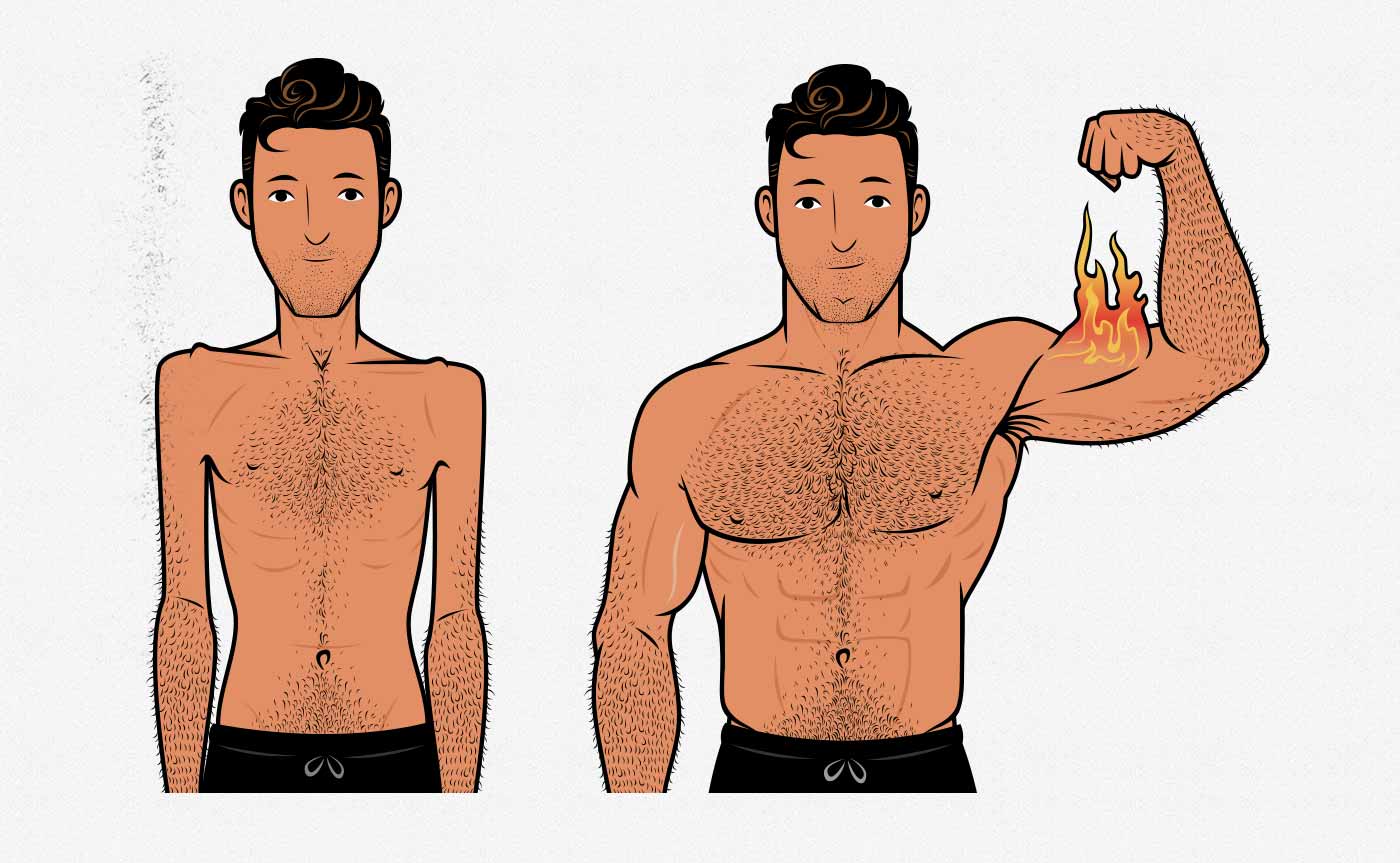
Maintenance and regaining lost muscle mass are very easy. There’s no need to stress out about losing your muscle mass, especially within the context of a fairly healthy lifestyle. Once you’ve earned it, it’s yours.

